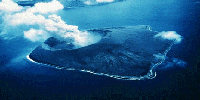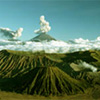|
|
 |
 |
The
Volcanoes
Indonesia belongs to one of the most volcanic
and seismically active regions in the world, with more than 400
volcanoes of which 128 are active, with 70 recorded eruptions in
historic times. The soil-rejuvenating effect of volcanic eruptions
has contributed to the fact that victims of threatened areas have
time and again returned to their stricken land.
So, the Volcanological Service has drawn hazard maps of volcanic
areas so that early warnings can be issued for the evacuation of
the people on time. Mountaineering clubs have in the past few years
sprung up in Jakarta, Bandung and other big cities and university
towns.
Among the most popular mountains for mountain climbing are the twin
volcanoes Gede and Pangrango in West Java, Semeru and Kelud in East
Java, Merapi in Central Java and Rinjani in Lombok. Expeditions
have also been made to the perennial snow-covered summit of the
Jayawijaya Range Carstensz Top in Papua.
Indonesia's internationally best-known volcano is perhaps the Krakatau
in the Sunda strait, midway between Java and Sumatra, whose calamitous
1883 eruption was commemorated in 1983.
The Wildlife Conservation and Nature Reserves
A vast archipelago with a total of 17,508 islands has
made Indonesia the home of a large variety of plant and animal life,
both terrestrial and aquatic. As the land mass is divided into islands,
often mountainous, many terrestrial species are endemic, originating
and living in one particular island or part of a larger island.
Zoologists divide Indonesia into three zones.
Zone I, nearest the Asian continent, was defined by British Naturalist
Alfred Russell Wallace in the 19th century. Climate did not appear
to be the deciding factor in his theory Wallace postulated that
because the islands of Sumatra, Java and Kalimantan were joined
to Asia by the now submerged Sunda Shelf, the Indo Malayan fauna
had not spread beyond the shelf's eastern boundary which came to
be known as the Wallace Line.
Zone II, is the intermediate zone between the Indo-Malayan zone
and Zone III where Australian animal and plant life predominate.
Sulawesi, in particular has an unusually high proportion of endemic
species and there is even a marked difference between the flora
and avifauna of Zone I and Zone III.
In Zone III, both the fauna and flora are predominantly Australian
in character and affinity, as these islands share the same continental
shelves, the Sahul Shelves with Australia. 
|












